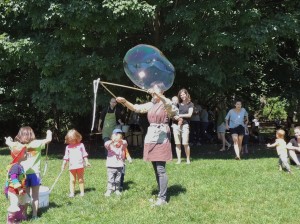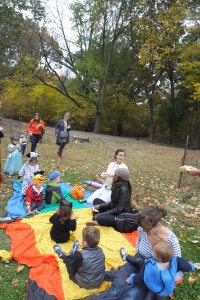City kids don’t often get to scramble over logs, stomp in puddles or get muddy unless you set up the opportunity and encourage it. As more families stay in New York City instead of moving to the suburbs, parents are starting to address this Nature-Deficit Disorder in a number of ways.
When I first wrote about Tinkergarten and its push for getting Brooklyn kids to explore and learn outdoors, I didn’t really understand the lay of the land. For starters, Prospect Park already has a big Forest School program. And Brooklyn even has its own Waldorf School (Nursery and kindergarten run about $20,000 a year.) Now that my daughter is a little older (2 1/4) and I’ve been thrust into the Brooklyn early education scrum, I’ve gotten a chance to look around. And I still really like Tinkergarten.
Ginger and I went to Forest School in Prospect Park over the summer and were delighted. There’s a simple ritual of meeting up and singing our way into the park. Then we’d play in the mud. If it were a competition to be the muddiest–and Forest School is the opposite of that–Ginger would have won every week. Then our sweet teacher Jane Yoo would gently start singing “Wash Hands,” a song that is still part of our lives. Kids would line up to wash their hands in a bowl, then sing “Dry Hands” as they wiped off, so they could get fresh-baked delicious bread and Saskatoon tea. Eventually Ginger realized how delicious the bread was and by the last class she cut her mud play short to chant “Bread! Bread! Bread!” Then we’d have short activity, like checking out a tree stump.
The founders of the school, Joylynn Holder and her husband, Charlie Foster, told the New York Times that the rituals becalmed students. And it is weirdly true. When we left class Ginger and I were inevitably in a better, happier mood. Students learn from adults modeling good behavior instead of telling them what to do, they think. Jane, our delightful teacher, was a good model to me. We have to cross the busy park road, which often stresses me out because cyclists ignore the lights, even for a group of strollers. Jane was always admirably calm, but firm, with them. The founders also told the Times they emphatically aren’t out to teach the kids species names or anything so specific. Instead, it’s about slowing down. The small group always had two or three adults to keep things running gracefully.
This fall we tried Tinkergarten, which does aim to teach kids a little about the outdoors. There’s less of a schedule and a lot of letting toddlers happen to the plan. One of the most useful things I learned from Meghan Fitzgerald was to not try to worry about completing our lesson plan. Ginger is at a point where defiance is her hobby. She regularly seeks out human hairs to eat because she knows it drives me crazy. Ginger liked to start class by announcing she wouldn’t get out of the stroller. So Meghan would just invite me to pull the stroller up and let Ginger come out on her own. Or not. But she’d usually see what the other kids were doing and want to join in.
Tinkergarten is a mix of outdoor play and a project, usually an art project, though sometimes learning about a specific tree. This is a different philosophy than Forest School. We learn and do. During the session I listened to a the BBC Wildlife podcast with Miranda Krestovnikoff, new president of the RSPB, who was saying her family never just went for a walk. Instead they were always building collages or collecting something. The sense of purpose–however fleeting–pushes you to get excited about your quest and the outdoors. Meghan might have the kids collect leaves into color piles, then just leave them. I’ve often thought that why hunters are so much more dedicated than wildlife watchers is that they set out on a mission.
We also experimented with an outdoor playgroup run by another teacher and mom, Jackie Wolff, who teaches yoga with kids and does a free storytime in the park. As simple as “play outdoors with toddlers” seems, I do think we heavily rely on Jackie and her organizing the day. Each week one mom (or family) runs the activity and one brings the snack and then each of us bring part of the regular supplies. This is, as you might imagine, the least structured of the three options–also the cheapest. If it’s a nice fall day we might just find a fun spot to play in the leaves and logs. On the other hand, I’ve learned some fun crafts and skills from other parents (Bill taught us to use acorns as whistles). Because we’re running the class, we end up talking a lot more. The best thing about the playgroup is getting to talk with the other moms both about how we’re going to run the class and about other toddler issues we’re up against.
 With all these organized programs, I can’t forget my most favorite outdoor leaders, our beagles Moxie and Huckleberry. We take them out in the park every morning, for adventures that can sprawl on for hours and miles. It’s part of our day–probably the favorite part for both me and Ginger. Her rallying cry is “Dog beach, dog beach,” not because we do all that much at the dog friendly spot on a small lake in Prospect Park. It’s just her way of saying she wants to go deep into the park and play.
With all these organized programs, I can’t forget my most favorite outdoor leaders, our beagles Moxie and Huckleberry. We take them out in the park every morning, for adventures that can sprawl on for hours and miles. It’s part of our day–probably the favorite part for both me and Ginger. Her rallying cry is “Dog beach, dog beach,” not because we do all that much at the dog friendly spot on a small lake in Prospect Park. It’s just her way of saying she wants to go deep into the park and play.




Recent Comments